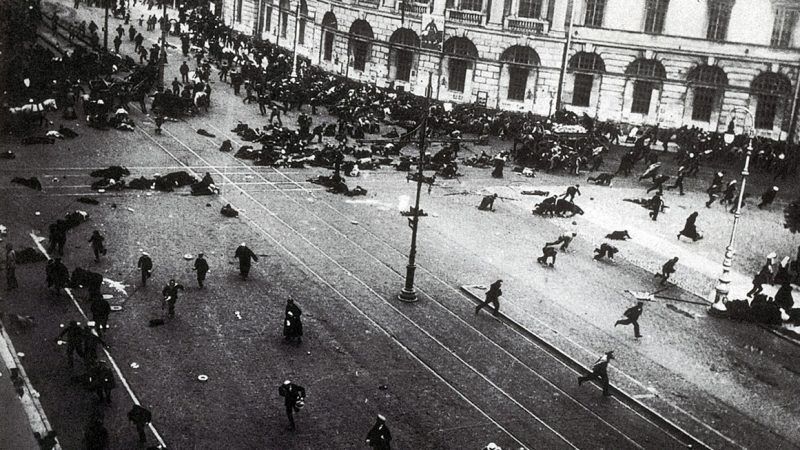Hard Lessons From the Russian Civil War

The official 100th anniversary of the Russian Revolution, which birthed the world's first Communist state, came and went two years ago. But the revolution actually played out over five horrific years known as the Russian Civil War. A century ago this summer, the anti-Bolshevik White forces were running a fully functional government in northern Russia. Their "Supreme Ruler," Admiral Alexander Kolchak, was internationally recognized as the head of state, and their army was crushing the Bolsheviks in the South. By November 1919, the tide had turned. By the time the war was over, between 7 and 12 million were dead, and the Communists were victorious.
The Soviets' civil war mythology presented the conflict as a heroic story about workers and peasants defeating the combined forces of upper-class Russian reactionaries and Western interventionists. The Russian émigré mythology treated it as a heroic story of idealistic patriots crushed by the forces of darkness. But the real Russian Civil War was far more complicated than either of those narratives.
Besides the Reds and the Whites, there was the roughly 100,000-strong Black Army led by anarchist and Ukrainian independence fighter Nestor Makhno, who started out in the Bolshevik camp before going his own way. There were also the nationalist forces of the Ukrainian People's Republic and the little-known Green Armies—peasant and Cossack militias and guerrilla units that may have been more than 70,000 strong at their peak. The Greens, thought to have gotten the name either from living in the woods or from having green banners, despised all the other factions, and their machine-gun carts sported the motto "Beat the Whites till they turn red, beat the Reds till they turn white."
As befits a Hobbesian war of all against all, this one was marked by exceptional brutality. The Bolsheviks visited horrific reprisals on villages in rebellious regions: "The shooting of dozens, even hundreds, of peasants for every dead communist was often threatened and sometimes practiced," wrote Italian historian Andrea Graziosi in his 1996 book The Great Soviet Peasant War. They also requisitioned grain and other supplies under a policy of pillage known as "War Communism," using torture to extract hoarded food. Peasants were forcibly recruited into the Red Army; so were former Tsarist military officers, their families often held hostage to ensure compliance. This cohort made up as much as 75 percent of the Reds' officer corps, a detail omitted from Soviet narratives of Red heroics.
The White Army also practiced forced conscription and often carried out punitive measures such as mass floggings, though Bolsheviks led the field in wanton slaughter. In the 2004 monograph Population Losses in the 20th Century, Russian historian Vadim Ehrlichman estimates the toll of Red terror at 1.2 million. That compares to some 300,000 for White terror and about 500,000 combined for other factions and guerrilla units (many of which, Ehrlichman notes, were little more than bandit gangs). Anti-Semitic pogroms—mostly by Ukrainian nationalists, Greens, and parts of the White Army, but sometimes also by Reds who targeted the Jewish bourgeoisie—took as many as 150,000 lives.
While many of the White movement's leaders ostensibly espoused liberal ideas, it is safe to say that freedom had no real friends in the Russian Civil War. Still, it's a virtual certainty that Russia—and most likely the world—would have been better off if the Whites had won.
They didn't, for many reasons. They were just as unpopular as the Bolsheviks and more divided. Their leaders clung to Russia's "great power" status and were adamantly opposed to Ukrainian independence or autonomy for other regions, which forced them to fight both the Bolsheviks and the separatists. The Bolsheviks, meanwhile, were not only more unified but more unscrupulous in their strategic alliances: They joined forces with Makhno's anarchists only to turn on them the moment the White Army was no longer a threat.
A hundred years later, Russian Communism is gone; in its place is an authoritarian regime that promotes Soviet nostalgia—a sentiment shared by too many in the West—but also glorifies White Guard leaders such as Kolchak and Anton Denikin (whose remains were returned from the U.S. in 2005 and reburied at Vladimir Putin's personal expense) as true patriots. The most trenchant lesson for the modern age is one that also seems increasingly relevant to the West: When political adversaries are no longer fellow citizens to live with but rather enemies to be crushed, we all lose.



Show Comments (67)